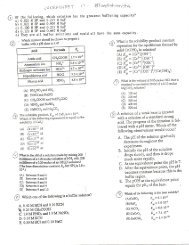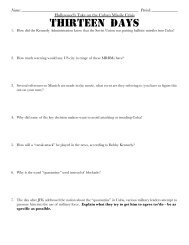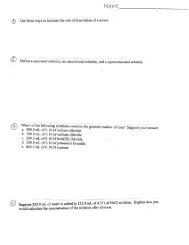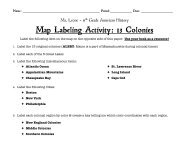Chapter 16 Text
Chapter 16 Text
Chapter 16 Text
You also want an ePaper? Increase the reach of your titles
YUMPU automatically turns print PDFs into web optimized ePapers that Google loves.
<strong>16</strong>.6 Weak Acids 635<br />
[TABLE <strong>16</strong>.3 Acid-Dissociation Constants of Some Common Polyprotic Acids<br />
Name<br />
Ascorbic<br />
Carbonic<br />
Citric<br />
Oxalic<br />
Phosphoric<br />
Sulfurous<br />
Sulfuric<br />
Tartaric<br />
Formula<br />
H2C6H606<br />
H2C03<br />
HsQ^sO?<br />
H2C2O4<br />
H3P04<br />
H2S03<br />
H2SO4<br />
H2C4H4O6<br />
•K«i<br />
8.0 x 10~5<br />
4.3 x 10~7<br />
7.4 X 10~4<br />
5.9 X 10~2<br />
7.5 X 10~3<br />
1.7 X 10~2<br />
Large<br />
1.0 X 10~3<br />
Ka2<br />
1.6 X 10"12<br />
5.6 X 10"11<br />
1.7 X 10~5<br />
6.4 X 10~5<br />
6.2 X 10~8<br />
6.4 x 10~8<br />
1.2 X 10~2<br />
4.6 X 10"5<br />
-K«3<br />
4.0 X 10"7<br />
4.2 x 10~13<br />
SAMPLE EXERCISE <strong>16</strong>.13<br />
The solubility of CO2 in pure water at 25°C and 0.1 atm pressure is 0.0037M. The common practice is to assume that all of the dissolved<br />
CO2 is in the form of carbonic acid (H2CO3), which is produced by reaction between the CO2 and H2O:<br />
What is the pH of a 0.0037 M solution of H2CO3?<br />
CO2(«^) + H2O(I) v<br />
H2CO3(ag)<br />
Solution<br />
Analyze: We are asked to determine the pH of a 0.0037 M solution of a polyprotic acid.<br />
Plan: H2CO3 is a diprotic acid; the two acid-dissociation constants, Kal and Ka2 (Table <strong>16</strong>.3), differ by more than a factor of 103. Consequently,<br />
the pH can be determined by considering only Kfll/ thereby treating the acid as if it were a monoprotic acid.<br />
Solve: Proceeding as in Sample Exercises<br />
<strong>16</strong>.11 and <strong>16</strong>.12, we can write the<br />
equilibrium reaction and equilibrium<br />
concentrations as follows:<br />
Initial<br />
Change<br />
Equilibrium<br />
0.0037 M<br />
-xM<br />
(0.0037 - x) M<br />
H>y) 4- HC03-(aj)<br />
0<br />
+xM<br />
xM<br />
0<br />
+xM<br />
xM<br />
The equilibrium-constant expression<br />
is as follows:<br />
Solving this equation using an equation-solving<br />
calculator, we get<br />
Alternatively, because Knl is small, we<br />
can make the simplifying approximation<br />
that x is small, so that<br />
= [H+][HC03-] = (*)(*)<br />
[H2CO3] 0.0037 - x<br />
x = 4.0 x 10~5 M<br />
0.0037 ~ * « 0.0037<br />
= 4.3 X 10~7<br />
Thus,<br />
Solving for x, we have<br />
(*)(*) - 4.3 X 10<br />
~7<br />
0.0037<br />
x2 = (0.0037) (4.3 x 10"7) = 1.6 X 10"<br />
The small value of x indicates that our<br />
simplifying assumption was justified.<br />
The pH is therefore<br />
x = [H+] - [HCO3~] - Vl.6 x 10~9 = 4.0 X<br />
pH = -log[H+] = -log(4.0 x 10^5) = 4.40<br />
M<br />
Comment: If we were asked to solve<br />
for [CO32~], we would need to use<br />
Ka2. Let's illustrate that calculation.<br />
Using the values of [HCO3~] and [H+]<br />
calculated above, and setting<br />
[CO3 ] = y, we have the following<br />
initial and equilibrium concentration<br />
values:<br />
Initial<br />
Change<br />
Equilibrium<br />
4.0 x 10"5 M<br />
-yM<br />
(4.0 X 10~5 -.y)M<br />
4.0 X 10~5 M<br />
+yM<br />
(4.0 X 10"5 + y) M<br />
+<br />
0<br />
+i/M<br />
yM<br />
Assuming that y is small compared<br />
to 4.0 X 10~5, we have<br />
[H+][C03 2-1 (4.0 X<br />
~5 - 5.6 X 10~u<br />
[HC03-] 4.0 x 10<br />
y = 5.6 X KT11 M = [CO32~]
















